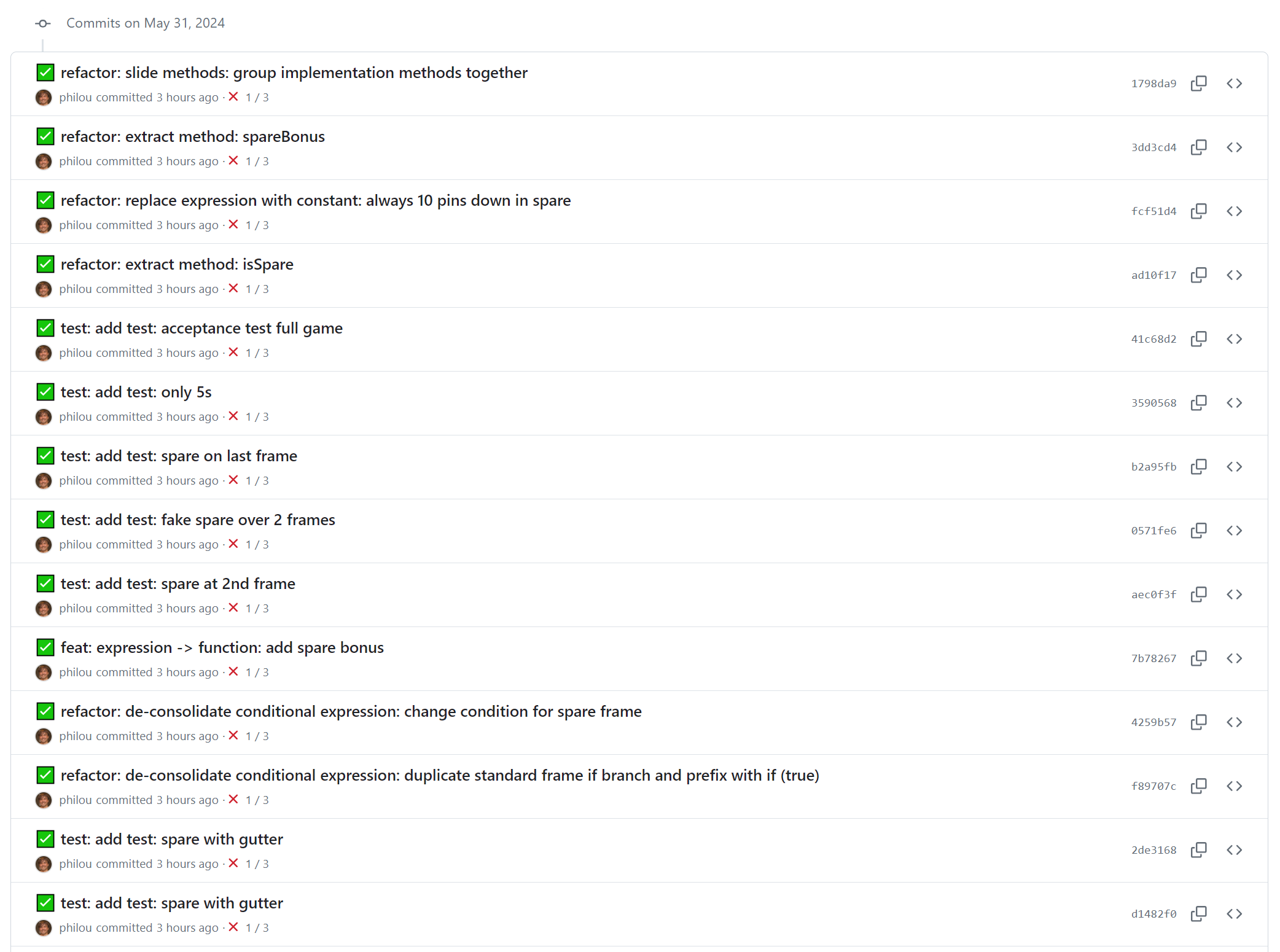
"AI Generated Golf" by Ray Shrewsberry is licenced under Pixabay License
Let's see how many baby steps you need to solve this problem!
You can fill it from here
- Catalog of refactoring:
- Catalog of Transformations:
- SPIDR Story Splitting:
- Make the change easy, then make the easy change
- Conventional Commits
- Collaborative timer for pairing or mobbing: mobti.me or agility timer
The goal of this kata is to practice updating working software with the smallest number of baby steps possible!
- Builds on TDD and TCR
- Understanding what we call a "baby step"
- Awareness that baby steps have names
- Understanding the difference between Refactoring (that preserve behaviour) and Feature (that change behaviour) baby steps.
- Learning to separate 'design' and 'feature' work
- Understand how baby-steps support continuous refactoring within user stories
- Understand how baby-steps support user story splitting that maximizes early value delivery
- "Make the change easy, then do the easy change" instead of "Making the difficult change directly"
You can practice using either of these styles:
- 2-hour Prepared Kata
- 2-hour Randori in Pairs
- 2-hour Randori Kata
- 2-hour Mob Kata
This kata should be played like a Golf track! Here are the rules of Golf that are relevant to us:
- The goal of Golf is to get the ball in the hole with the minimal number of strikes
- A Golf track consists of multiple holes
- Each hole has a known "par" which is the typical number of strikes that a player would need
PerlGolf is an old programming version of the Golf: the goal is to write a program with the least characters possible.
Here we are we will use another adaptation of the Golf. We will have to implement the user story with the least baby-steps possible. Each baby step should be represented by a commit. Commits should be small and represent an elementary modification to the Abstract Syntax Tree of the program. You can find a catalog of these transformations here (refactoring) and here (feature).
This kata comes with a custom test runner script golf-tcr.sh. It's an adaptation of the TCR workflow that creates baby-steps commits with custom error messages.
These messages help us to keep track of the scoring during the game 😄
TCR stands for test && commit || revert. Whenever you run your tests, if they pass, the code is committed, otherwise, every change is reverted.
This nudges to:
- do small changes that are safer and less of a problem when reverted
- tweak the TDD loop:
- from
Red -> Green -> Refactor -> ... - to
New test is reverted to Green -> Refactor to make the change easy -> New test is committed to green with an easy change -> ...
- from
Here is a sample workflow:
- Add (or enable, or uncomment) a test
- run
./golf-tcr.sh test "add test" "..." - If the tests pass, TCR commits and pushes with a message "✅ test: Add Test: "
- Otherwise, TCR reverts the code and the tests
- You should have learned what is needed to pass the tests
- Make the change easy: through baby-steps, prepare the code to pass the test, run
golf-tcr.shat every step - Do the easy change: re-enable the test, with everything ready, you should be able to make the small code changes required to pass the test
- run
golf-tcr.shagain - Depending on the tests result, Go back to 3. or 4.
Here is a sample commit log:
The facilitator will first demo what all this looks like in practice
Pairs or mobs should create a custom branch, so that the facilitator can keep track of their progress and create a leaderboard!
here is how to use golf-tcr.sh:
Usage: ./golf-tcr.sh <commit type> <baby step type> <details>
- commit type: one of: [feat refactor test fix chore docs style perf build ci revert] (cf https://www.conventionalcommits.org/en/v1.0.0/)
- baby step type:
- for refactorings, check: https://refactoring.com/catalog/
- for features, check: see https://en.wikipedia.org/wiki/Transformation_Priority_Premise
- details: extra info about the change
Like any game, you can cheat and cut corners... But the facilitator is looking over your shoulder! 😉
- Hiding plenty of changes in a single commit is the golf equivalent of losing your ball (in the water or outside the track). You'll get a penalty of 20 points! So spend the time to find the exact baby step you are using before committing.
- Don't leave the code in a mess! Otherwise, you risk disqualification! So take the time remove duplication and make the code readable
Hopefully, it will be fun!
This kata consists of 4 "holes", which are features to add to existing working software. Each feature has a 'par': a typical number of baby steps it can be implemented with. You might do better than the par, or worse. You can replay a hole to reduce your number of baby steps.
This example is used to demo the concept of baby-steps golf to participants
- User Story: As a bowling shop owner, I want to add spares to my scoring algorithm, so that the players can have more fun!
- Difficulty: Easy
- Par: 7
- Story Split by: RULES, baby steps programming let us safely postpone more advanced rules, while letting players enjoy a working fun game early
- Hints:
- Duplicate if branch
- User Story: As a birthday party organizer, I want to add "Bazz" for multiples of 7, so that I have a more difficult game for experienced FizzBuzz players
- Difficulty: Easy
- Par: 10 (or 22 if we count every similar branch change separately)
- Story Split by: RULES, baby steps programming let us safely postpone more advanced rules, while letting players enjoy a working fun game early
- Hints:
- We prepared new tests that are marked @Disabled
- Introduce an accumulator
- User Story: As a math geek, I want to make the triangle display isosceles, so that it looks more like the traditional image we have of Pascal's Triangle
- Difficulty: Medium
- Par: 14
- Story Split by: INTERFACES, baby steps programming let us safely postpone improvements to the display, while letting users enjoy a working yet minimalistic display early
- Hints:
- We are using the Strangler pattern to change the display while keeping everything working. "legacy" code is prefixed and marked as @Deprecated. We will need to delete it at the end.
- Introducing 'identity' function or operations are a nice way to make code emerge
- User Story: As a giant display panel operator, I need to specify a size for the LCD display, so that I can display important information in bigger letters
- Difficulty: Difficult
- Par: 21
- Story Split by: DATA, baby steps programming let us safely postpone the less used cases, while letting users use a working display on the most frequent input early
- Hints:
- Object method pattern
- Encapsulate accessor
Kata-BabyStepsGolf and the accompanying materials are made available
under the terms of the MIT License which accompanies this
distribution, and is available at the Open Source site
See ACKNOWLEDGEMENTS.md for more information.
